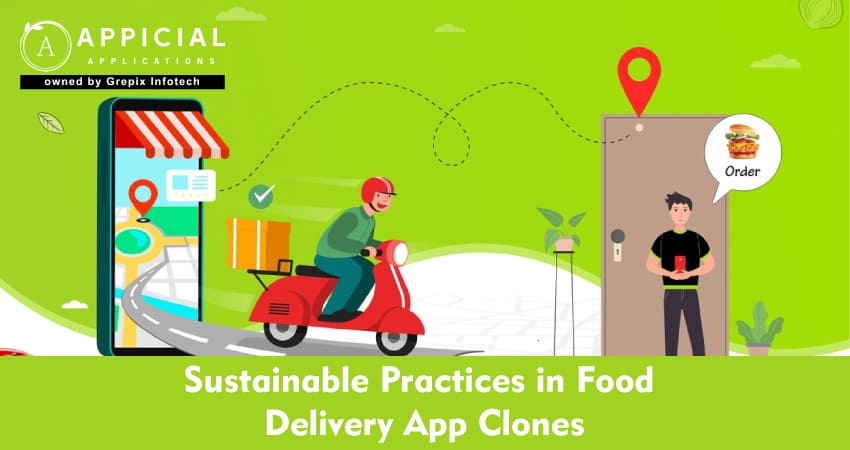
Sustainable Practices in Food Delivery App Clones
We’ve all done it. It’s 8 PM. You’re tired. The fridge is empty. You pick up your phone and scroll through your favorite delivery app. A few taps later, dinner is on the way.
Convenient? Absolutely. But here’s the thing every order comes with a cost. And I’m not just talking about your wallet.
Plastic containers. Styrofoam boxes. Gas-powered scooters zigzag through traffic. Multiply that by millions of orders a day, and suddenly, your sushi craving doesn’t feel so harmless anymore.
That’s the dilemma.
Food delivery apps have become a lifeline. But they’ve also added to our environmental footprint. The question is, can we keep the convenience without sacrificing the planet?
Good news: we can. And it starts with sustainable food delivery practices built right into the code and culture of app clones.
Let’s talk about how.
This blog dives deep into the urgent need for sustainability in the booming food delivery industry. From electric vehicles and compostable packaging to smart route optimization and customer-driven eco features, the article explores innovative strategies used in sustainable food delivery app clones. It highlights how app developers can reduce environmental impact while enhancing user experience through transparency and engagement. The blog also showcases the role of tech partners like Appicial Applications in helping businesses build the next-generation eco-friendly delivery app smart, green, and future-ready.
The Importance of Sustainability in the Food Delivery Space
We are not in the early 2000s anymore.
Today's customers want more.
They want to know what is in their food and how they get it.
And frankly, they should.
The old delivery model is shattered. It's inefficient. It's archaic.
And if we're committed to solving climate change, we can't afford to ignore it anymore.
Here’s why it is so important:
- The packaging problem: Most takeout comes in plastic. It doesn’t break down. It ends up in oceans, harming wildlife.
- The delivery issue: Gasoline-fueled vehicles pump out carbon dioxide. Every delivery, especially one made inefficiently, adds to global emissions.
- The scale: With millions using delivery apps every day, even small changes can have huge ripple effects.
That’s why sustainable food delivery isn’t a trend. It’s a necessity.
As we clone successful food delivery apps, there's a golden opportunity: bake sustainability right into the foundation. Instead of patching it on later, why not start with green practices from Day 1?
That brings us to eco-friendly innovations in the delivery process.
Eco-Friendly Delivery Methods: Greener Ways to Get Your Food
Let's debunk the myth now: sustainability does not equal inconvenience.
Most green delivery app alternatives are wiser, quicker, and even cheaper. Here's how innovative clones are revamping the path from restaurant to doorstep.
1 Electric Vehicles (EVs) and E-bikes
Replacing gas with electricity is perhaps the simplest and most powerful modification. Urban areas around the globe are witnessing an explosion in the use of electric scooters, e-bikes, and small EVs for last-mile delivery.
- Why it works: EVs cut emissions by as much as 70% over traditional vehicles.
- What app clones can do: Partner with green vehicle fleets or offer incentives for delivery partners to go electric.
For shorter routes, e-bikes are perfect. They’re agile, emission-free, and require minimal parking.
2 Smart Route Optimization
This is where tech truly shines.
With better algorithms, delivery apps can group orders more efficiently, reduce unnecessary mileage, and save fuel. It’s like carpooling but for dinner.
- Less travel time = lower carbon footprint.
- Fewer vehicles on the road = less congestion and emissions.
A well-designed green food app clone doesn’t just send drivers from point A to B. It thinks strategically.
3 Carbon-Neutral Partnerships
Some companies are taking it even further by offsetting their emissions through certified programs—planting trees, investing in renewable energy, and more.
Imagine your food app showing a “carbon-neutral” badge next to your order. That’s branding and ethics rolled into one.
Delivery clones can integrate APIs to calculate emissions and offer offset options right in the checkout process.
It’s seamless. And it builds customer trust.
What are the Steps to Reduce the Carbon Footprint?
You don’t need to reinvent the wheel. Reducing your app's carbon footprint is often about optimizing the parts you already have.
1 Sustainable Packaging
Here’s a stat that’ll stop you mid-bite: 78% of food delivery packaging is not recyclable.
But we can change that.
- Switch to compostable materials like cornstarch-based containers or biodegradable cutlery.
- Encourage customers to go cutlery-free by making it the default option in the app.
- Partner with eco-conscious restaurants that already use sustainable packaging.
- Better yet, let customers filter restaurants by “low-waste packaging.” People love control, and this gives it to them.
2Less Plastic, More Bulk
Instead of single-portion packets of ketchup or soy sauce, apps can nudge restaurants to use small reusable containers or bulk options.
Or even better? Make sauces optional during checkout. Fewer “default” add-ons mean fewer wasted items.
3 Batching Orders
Another simple but powerful tweak.
Instead of sending one driver for every single order, batch deliveries are made by neighborhood or timing. It’s already common with grocery apps, but rarely used for takeout.
This one move cuts down on fuel use and reduces delivery times.
Customer Engagement: Making the User Part of the Mission
Sustainability can’t be one-sided. If customers aren’t on board, it falls flat.
So, how do you make them care?
You involve them. You make it easy. And when possible you make it fun.
1 Green Gamification
Everyone loves a little challenge.
- “You’ve avoided 2 pounds of plastic this month!”
- “Earn badges for low-carbon choices.”
- “Get discounts for eco-friendly orders.”
It sounds simple, but gamification is powerful. It taps into our love of progress and recognition. A green food app clone can make this part of its core UX.
2 Transparency Tools
People trust what they can see.
Show them:
- The carbon impact of their order
- Whether their food came in sustainable packaging
- The delivery vehicle type
Information builds trust and loyalty.
3 Eco Options at Checkout
Instead of defaulting to convenience, let users choose sustainability.
- “Add $0.50 to offset your delivery’s carbon footprint?”
- “Opt out of single-use items?”
- “Choose a slower, more sustainable delivery window?”
Give them agency. People want to help they just need the tools.
Also Read: How to create a food delivery app like UberEats, Grubhub, DoorDash, or Deliveroo?
Case Study: What Success Looks Like?
Some companies are already doing this right.
A few European delivery apps have gone fully electric. Others have banned plastic cutlery altogether. Some even deliver meals on foot in dense cities.
It’s not science fiction. It’s real. And it’s working.
These companies aren’t losing customers, they’re gaining them. Especially among younger, climate-conscious users.
So if you’re building or cloning an app, here’s the takeaway: going green isn’t just good ethics. It’s good business.
Appicial Applications: Your Partner in Building the Future
You don’t have to start from scratch.
Appicial Applications has been in the trenches, building robust, scalable food delivery app clones that already prioritize sustainability.
Their platforms are customizable, future-proof, and built with eco-friendly features in mind. Whether it’s integrating EV-friendly dispatch systems or embedding carbon offset tools, they’ve thought of it.
So if you're dreaming of launching the next eco-friendly delivery app, partner with experts who get it.
Appicial combines cutting-edge tech with a deep commitment to sustainable food delivery. They're not just keeping up with the green wave, they’re helping lead it.
Final Thoughts: Why This Matters More Than Ever?
Let’s be real. Climate change isn’t coming, it’s already here. As entrepreneurs, developers, and users, we all share the responsibility to do better.
Food delivery isn’t going anywhere. But it can evolve. And with the right mindset and the right tech-it can evolve into something beautiful.
Something that feeds people and protects the planet.
So the next time you think about building or using a food delivery app, ask yourself:
Is it fast?
Is it tasty?
If not, it’s time for a change.
And if you’re ready to build that change, Appicial Applications is here to help you every step of the way.
Make your app deliciously convenient. And brilliantly sustainable. Start your green journey today with Appicial Applications.
Looking out to start your own venture like Zomato ? Try out our Masaladish Zomato Clone, the easiest way to kick start your food delivery business.Author's Bio

Vinay Jain is the Founder at Grepix Infotech and brings over 12 years of entrepreneurial experience. His focus revolves around software & business development and customer satisfaction.
Back to blog list




